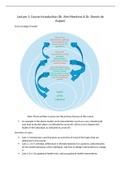Lecture 1: Course Introduction (Dr. Ree Meertens & Dr. Dennis de
Ruijter)
Socio-ecological model
Note: Those written in green are the primary focuses of this course
An example in the above model: work characteristics (such as a very stressful job)
may lead to alcohol abuse, as indicated by arrow #2, which in turn impacts the
health of the individual, as indicated by arrow #3
Overview of cases
Case 1: Introductory case that gives an overview of most of the topics that are
addressed in this course
Case 2, 3 & 4: Lifestyle, differences in lifestyle between EU countries, (determinants
of) the health behaviour of the individual, and how to design interventions to change
it
Case 5 & 6: Occupational health risks, and occupational health interventions
, Case 8 & 9: EU regulations that relate to work and lifestyle
Case 10: similar to case 1, this case combines the issues that were dealt with in the
course
Case 7 & 11: wrap us cases
Example of work intervention types
Elimination or substitution of the hazardous substance
o How do you choose between elimination and substitution?
Redesign of the work station or process
Education of workers
Use of personal protective equipment
Planning for emergency responses
, Lecture 2: Lifestyle and Work Among People with a Lower
Socioeconomic Position (Dr. Gera Nagelhout)
Health inequalities
Socioeconomic position: the social standing or social class of an individual or group,
often measured as a combination of education, income and occupation
Lower socioeconomic position is associated with higher levels of obesity, tobacco
use, chronic diseases, depression, social problems, chronic stress and shorter lives
Health inequalities within countries:
o Within Netherlands, lower educated people die six years earlier than higher
educated people
There is a vicious cycle with socioeconomic inequalities
o Lower SES increases risks of many diseases, which in turn make it harder to
improve one’s SES as it’s more difficult to attain education or work
People with low income are often focused on improving their financial position
meaning they do not have time or mental resources to improve other aspects of
their lives (‘scarcity theory’)
In the ‘health-poverty trap’ those who both seek healthcare and do not seek
healthcare end up with less disposable income and can’t escape the loop of
insufficient resources (see flow chart below)
, Work inequalities
Material & structural factors (living/housing conditions, working characteristics,
financial problems, relative income) are most important because they have a direct
impact on SES but are also the largest influence on behavioural factors (Moor et al.,
2017)
o However, this study had the limitation of few studies reviewed, heterogenous
results (different results in each study) and focused on the general population
and not work factors separately
Dieker et al. (2019) reviewed physical work factors (heavy lifting, noise exposures,
safety risks) and psychosocial work factors (work pressure, job insecurity) and found
this explained approx. 1/3 of the socioeconomic inequalities in self-rated health
o Lifestyle factors explained 1/5 of the relation between SEP and self-rated
health
o Also had heterogenous results in the studies reviewed and most studies were
cross-sectional (21 out of 27)
Mediation & Moderation effects:
o Mediation: Work characteristics influence SEP which influences Health
o Moderation: Work characteristics influence the relationship between SEP and
Health (the strength, direction, or presence)
o The inverse is also possible, where SEP influences work characteristics that
influence health
Job strain: people with lower SEP have more job strain (high job demand, low
control) than higher SEP
o Job strain was associated with unhealthy lifestyle and it’s absence was
associated with healthier lifestyles
o However, lack of evidence for causality





